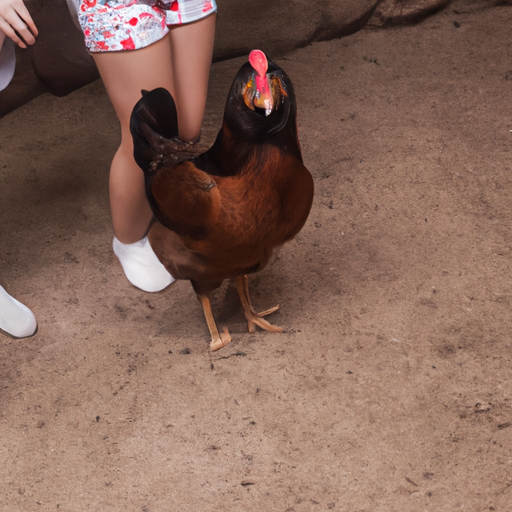So, you’ve decided to add some new feathered friends to your existing flock of chickens, but you want to ensure a smooth transition and the safety of everyone involved. Well, fear not! In this article, we will guide you on how to introduce new chickens to an established flock in a safe and stress-free manner. Whether you’re a seasoned chicken owner or new to the backyard poultry game, these tips and tricks will help you create a harmonious coop where all the hens can happily cluck away.
Preparing for Introduction
Assessing the existing flock
Before introducing new chickens to your established flock, it is crucial to assess the dynamics and health of your existing flock. Take the time to observe their behavior, noting any signs of aggression or illness. Understanding the existing flock’s temperament and hierarchy will help you plan a successful introduction strategy.
Quarantine and health evaluation
To ensure the health and well-being of both your existing flock and the new chickens, it is essential to quarantine the newcomers for a period of time. This quarantine period allows you to evaluate their health and prevent the spread of any potential diseases. During this period, it is advisable to consult with a veterinarian to conduct a thorough health assessment to ensure the new chickens are fit for introduction.
Creating a separate space for new chickens
Before introducing the new chickens to the established flock, it is important to create a separate space for them. This separate space can be a coop or an enclosure that allows the new chickens to see and interact with the existing flock while still providing physical separation. This gradual introduction method will help the chickens adjust to each other’s presence without the risk of direct confrontation.
Gradual Introduction Method
Using separate but visible enclosures
The gradual introduction method involves initially housing the new chickens in a separate but visible enclosure. This allows the existing flock to see, hear, and smell the new chickens, promoting familiarity. The separate enclosures should be placed close enough for the chickens to observe each other’s behavior, but with enough distance to prevent physical contact. This method helps minimize the stress and anxiety that direct confrontation may cause.
Feeding near each other
To further facilitate a gradual introduction, consider placing feeding stations for both the existing flock and the new chickens near each other. This allows the chickens to associate positive experiences, such as eating, with each other’s presence. Over time, they will become comfortable sharing a feeding area and reduce the potential for aggression during meal times.
Short supervised interactions
Once the new chickens and the established flock have become acclimated to each other’s presence, you can start introducing short, supervised interactions. This can be done by allowing the new chickens to free-range near the existing flock under close observation. This controlled environment allows you to intervene if any aggressive behavior arises and ensures the safety of all chickens involved.
Territory and Space Adjustments
Consideration of pecking order
When introducing new chickens, it is important to consider the pecking order within the existing flock. Chickens have a hierarchical social structure, and the introduction of new members can disrupt this order. Ensure that there is ample space and resources available for the chickens to establish a new pecking order. It is normal for some pecking and squabbles to occur initially, but monitor the situation closely to prevent excessive aggression.
Adding new perches and hiding spots
To help alleviate any potential conflict within the flock, provide additional perches and hiding spots. This creates multiple areas where chickens can retreat, minimizing stress and potential aggression. The added perches and hiding spots allow the chickens to establish their own territories and reduce the likelihood of confrontations.
Providing multiple feeding and watering stations
Having multiple feeding and watering stations is vital when integrating new chickens into an established flock. This ensures that all chickens have access to food and water without competition or aggression. Place the feeding and watering stations apart from each other to prevent overcrowding and promote harmonious feeding habits.
Supervision and Monitoring
Observing flock dynamics
Throughout the introduction process, it is essential to closely observe the flock dynamics. Take note of any changes in behavior, signs of stress, or persistent aggression. Pay attention to individual chickens’ well-being and ensure that each chicken is getting adequate access to resources and space. This ongoing monitoring allows you to address any issues promptly and make necessary adjustments.
Handling aggressive behavior
In the event of aggressive behavior among the chickens, it is crucial to intervene swiftly and appropriately. Separate any chickens involved in a physical altercation to prevent injuries. If necessary, consider reintroducing the aggressive chicken at a later stage when it has become more accepting of the new members. Handling aggressive behavior promptly will help maintain a peaceful and harmonious flock.
Ensuring adequate resources for all chickens
It is vital to ensure that all chickens, both existing and new, have access to adequate resources within the flock. This includes sufficient space, food, water, perches, and hiding spots. Inadequate resources can trigger aggressive behavior and lead to stress and malnutrition. Regularly assess the availability of resources and make adjustments to accommodate the needs of the entire flock.
Common Mistakes to Avoid
Introducing too many new chickens at once
One common mistake to avoid when introducing new chickens to an established flock is introducing too many new chickens at once. Adding a large number of unfamiliar chickens all at once can overwhelm the existing flock and increase the likelihood of aggression. Gradual introductions with smaller groups of new chickens allow for better integration and minimize stress.
Skipping quarantine period
Another mistake to steer clear of is skipping the quarantine period for the new chickens. Quarantine is crucial to protect the health of the existing flock and prevent the spread of diseases. Neglecting this important step can expose your entire flock to potential illnesses and compromise their well-being. Always prioritize the health and safety of your chickens by following a proper quarantine protocol.
Neglecting signs of stress or illness
Lastly, neglecting to recognize and address signs of stress or illness in both the existing and new chickens can have detrimental effects on the flock. Look out for indicators such as lethargy, loss of appetite, abnormal feather condition, or unusual behaviors. Promptly seek veterinary assistance if you suspect any signs of illness, as early intervention can prevent the spread of disease and support the overall health of the flock.
Conclusion
Introducing new chickens to an established flock can be a delicate process. By following a gradual introduction method, which includes separate enclosures, feeding near each other, and supervised interactions, you can help minimize stress and aggression among the chickens. When adjusting territories and spaces, consider the pecking order, provide additional perches and hiding spots, and ensure multiple feeding and watering stations. Supervision and monitoring play a crucial role in maintaining a harmonious flock, as does handling aggressive behavior promptly and ensuring sufficient resources for all chickens. By avoiding common mistakes such as introducing too many new chickens at once, skipping the quarantine period, and neglecting signs of stress or illness, you can create a safe and successful integration for your entire flock. Remember, patience, observation, and proactive care are key to fostering a healthy and thriving chicken community.




